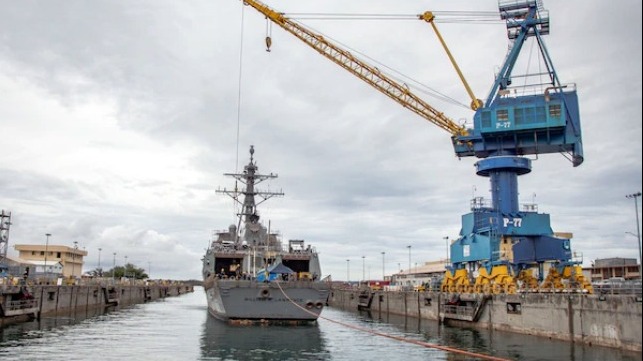$25 Billion Investment Proposed for U.S. Navy Shipyard Infrastructure

A bipartisan group of U.S. senators, supported by two Republican members from the House of Representatives, is proposing legislation to invest $25 billion to improve the U.S. Navy’s shipyard infrastructure. They said the proposed legislation would address the critical problems in the shipyard infrastructure by repairing, modernizing, and making critical capital equipment improvements at both the Navy’s public yards and the private shipyards and suppliers serving the Navy.
“The importance of our naval assets to our national security and global stability has never been greater, which is why it is so critical that our defense industrial base has the capacity to build and maintain a larger fleet,” said Senator Susan Collins, one of the five co-sponsors of the act. “If we are serious about the United States competing against and deterring China, we have to consider our vital defense infrastructure. Our bipartisan legislation would support infrastructure improvements at shipyards across the country to help reduce maintenance backlogs, increase safety and efficiency, and accommodate growth to counter China’s growing naval ambitions.”
Separate from the perennial debate over the size of the Navy’s fleet, a recent report from the Government Accountability Office assessed that Navy readiness has decreased since 2017. The GAO pointed to “limited maintenance capacity at private and public shipyards as the primary challenge for recovering ship and submarine readiness.”
Among the issues the Navy has pointed to is an aging infrastructure at the four public shipyards, which include Norfolk in Virginia, Portsmouth in Maine, Pearl Harbor in Hawaii, and Puget Sound in Washington. Reports have cited insufficient capacity, inefficient facility configurations, and aging infrastructure and equipment as factors contributing to exorbitant maintenance delays and backlogs. In 2020, the GAO reported that three-quarters of the maintenance work scheduled between 2015 and 2019 for aircraft carriers and submarines was completed late with over 7,400 days of maintenance delays.
The Navy has specifically identified a critical lack of dry dock capacity at the four public shipyards. For example, while 17 dry docks can service the older Los Angeles-class submarines, only 12 of the dry docks can accommodate their replacement, the Virginia-class submarine, and only seven will be able to service the new, 83-foot longer Block V Virginia-class submarine.
“The United States Navy depends on four American public shipyards to maintain and modernize our nuclear-powered submarines and aircraft carriers,” said Representative Rob Wittman of Virginia. “But our shipyards’ aging infrastructure fails to provide the capacity, configurations, or equipment necessary to maintain fleet readiness. These factors have not only resulted in a maintenance backlog amongst our current ships but has left us ill-prepared to grow our Navy to keep pace with China.”
The Shipyard Act (Supplying Help to Infrastructure in Ports, Yards, and America’s Repair Docks) calls for appropriating a total of $25 billion under the Defense Production Act, including $21 billion for the Navy’s public shipyards along with $2 billion for major private new construction shipyards serving the Navy, and $2 billion for private repair shipyards serving the Navy. The private shipyards include Ingalls Shipbuilding, Austal USA, Newport News Shipbuilding, Electric Boat, Bath Iron Works, Fincantieri Marinette Marine, and NASSCO General Dynamics along with approximately 20 major repair shipyards. Smaller private shipyards involved in naval shipbuilding and repair along with suppliers and subcontractors would also qualify for funding.
The timing of the initiative is meant to link into the larger debate beginning in the U.S. Congress of President Joe Biden’s proposals for sweeping investments into the broader U.S. infrastructure. “As lawmakers consider ways to improve our nation’s infrastructure, the facilities that support our Navy fleet should be a part of the conversation,” said Senator Roger Wicker, another of the co-sponsors. “Congress has already taken the important step of committing to a larger Navy, but our shipyards are having trouble servicing today’s 296-ship fleet and are clearly insufficient to maintain the 355-ship or larger fleet we need to counter China, Russia, and other adversaries.”
By proposing the appropriate under the Defense Production Act, it removes typical fiscal year constraints on appropriations increasing flexibility to enable the Secretary of the Navy to accelerate contract awards. Projects identified by the Secretary of the Navy that be funded would include improvements to shipyard infrastructure, construction of new dry docks, and other items to enable these shipyards to keep pace with the Navy’s current and future needs. The act would also fully fund the Navy’s current $21 billion Shipyard Infrastructure Optimization Program for the four public shipyards.
Sponsors of the legislation include senators Roger Wicker, Tim Kaine, Susan Collins, Angus King, and Jeanne Shaheen, along with representatives Rob Wittman and Mike Gallagher.
